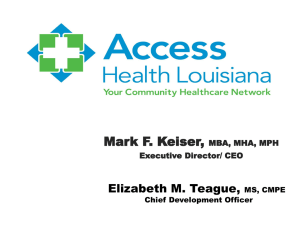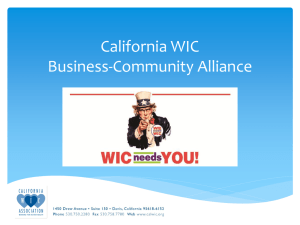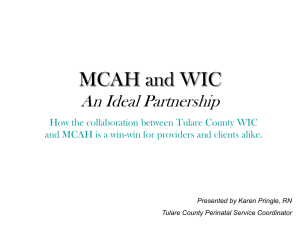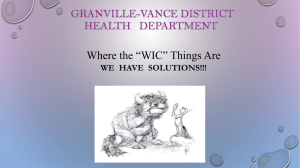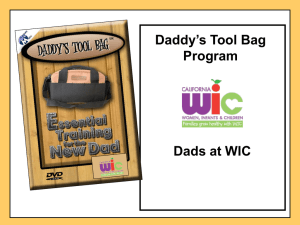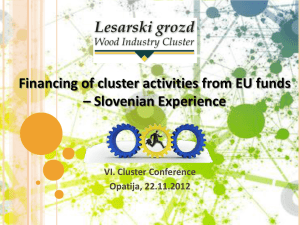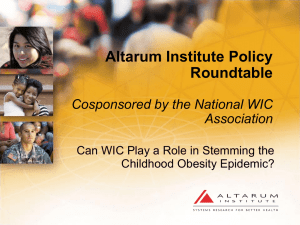A Community Health Center & WIC Program Model
advertisement
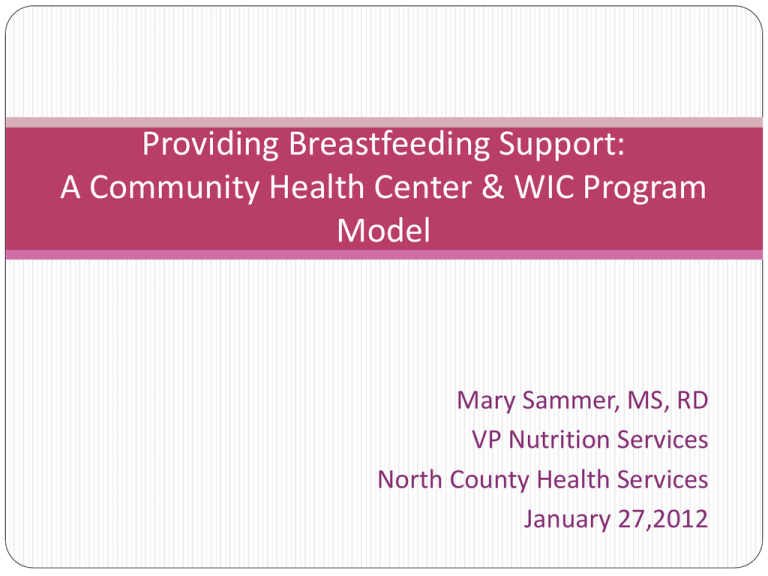
Providing Breastfeeding Support: A Community Health Center & WIC Program Model Mary Sammer, MS, RD VP Nutrition Services North County Health Services January 27,2012 Gaps in Breastfeeding Support: Low-Income Moms most Vulnerable Highest rates of Exclusive Breastfeeding are in hospitals with less ethnic diversity and moms with higher incomes. Lowest rates of Exclusive Breastfeeding are in hospitals serving large numbers of low-income women of color. WIC Moms Moms Using CHC’s for Healthcare California WIC Facts 60% infants born in California will be on WIC 84 Local WIC Agencies 78% WIC participants are Medi-Cal users Ethnicity: • 78% Hispanic • 9% White • 8% Black • 7% Other WIC serves Working Families with Incomes at or below 185% of the poverty level. North County Health Services (NCHS) The largest Community Health Center (CHC) in north San Diego county Ethnicity: 70% Hispanic, 23% white, 7% other Provides comprehensive health services to low-income or uninsured patients. OB/GYN and Pediatrics CPSP Providers (Comprehensive Perinatal Services Program) NCHS is a FQHC (Federally Qualified Heath Center) Designation that effects reimbursement NCHS Administers their own WIC program Share Patient Population Are these “Ingredients” for Breastfeeding Success? Exclusive Breastfeeding Rates Less than 1 month of age (by WIC Food Packet) 90% 80% 70% NCHS 60% CA WIC 50% POLICY CHG 40% 30% 20% 10% 0% Oct-04 Oct-05 Oct-06 Oct-07 Oct-08 Oct-09 Oct-10 Oct-11 Our Breastfeeding Model PRENATAL BREASTFEEDING EDUCATION WIC NCHS-OB POSTPARTUM SUPPORT WIC NCHS/WIC Moms and Babies POSTPARTUM SUPPORT NCHS-Peds HOSPITAL EXPERIENCE NCHS Prenatal Education & OB Services: WIC Program & NCHS PRENATAL BREASTFEEDING EDUCATION WIC NCHS-OB NCHS/WIC Moms and Babies During Pregnancy: WIC Mom’s Receive Platinum Breastfeeding Education & Support WIC Prenatal Group Education Why to Breastfeed How to Breastfeed Baby Behavior Prenatal Class Breastfeeding Discussed (monthly) at Every Individual or Group Contact. Benefits and risks of breast milk substitute. Encourage exclusive BF (norm), review AAP BF recommendations. Discuss USDA Policy “No formula in the first month”. Provide anticipatory guidance regarding the first weeks of BF. Use mom’s feeding intent (Excl BF, Combo, Formula) to direct counseling. First time moms offered Breastfeeding Peer Counseling Program Address any issues ppt. has regarding BF. OPPORTUNITY TO HARNESS PRENATAL BF EDUCATION PT RECEIVED IN WIC AT HOSPITAL AND ACKNOWLEDGE IT. NCHS Utilizes CPSP for “Prenatal Care” CPSP • • • California’s Medi-Cal Pregnancy Program A “Model of Enhanced Care” for low-income moms Utilizes a multidisciplinary team to meet all needs • 4 Components- Obstetrics, Nutrition, Health Education and Psychosocial • CPSP guidelines dictate services/frequency, providers • Visits reimbursable (FQHC, Medi-Cal, fee-for-services) NCHS – – – – – – OB Program is Midwifery Based Offer Childbirth Education classes Home-Visiting Nurse Program for first-time moms RD’s for Nutrition component/ WIC trained/CLE BF Services -IBCLC’s (CPHW) Physician Pediatrician/WIC Champion Hospital Support: NCHS NCHS/WIC Moms and Babies HOSPITAL EXPERIENCE NCHS Hospital Climate 3 Birthing Hospitals in our Area 1 is Baby Friendly (No NCHS deliveries) 2 Recently announced commitment to pursue Baby-Friendly Hospital Designation! (50% NCHS deliveries at each) NCHS & NCHS WIC participates on BF Task Force at our 2 primary delivery hospitals NCHS Impact at Hospitals 1) Pediatricians do own Newborn Rounding Investment in patient -> Medical Home Consistent breastfeeding messaging Control of feeding environment (first 24-72 hrs) 2) NCHS Health Educator (CPHW) Rounds at Hospital • • • • • Mom recognizes educator from pg Bicultural, Bilingual, Provides BF support (CLE) Fills gap in BF services at hospital Trust, Rapport, TLC Warm transition from Hospital to NCHS - make first “Peds visit” at clinic Postpartum Support : WIC Programs POSTPARTUM SUPPORT WIC NCHS/WIC Moms and Babies Postpartum Breastfeeding Services: WIC • Postpartum Support Calls within first days of life – BF Phone support and feeding assessment by a WIC IBCLC within the first 3-7 days of life. – Referral to NCHS or other MD if warranted – Study 2001 – -Impact of these Early PP phone calls significantly increased BF exclusivity and duration in our WIC population. • Bring couplet in to WIC – – – – CLE/IBCLC staff available Breastfeeding Peer Counseling Services Breastfeeding supplies, including electric breastpumps We are here to help them successfully breastfeed! Postpartum Support: NCHS NCHS/WIC Moms and Babies POSTPARTUM SUPPORT Pediatrics NCHS Postpartum Support: Pediatrics • First 3 Day Couplet Visit Infant • Pediatrician, newborn physical Mother: • sees IBCLC, Maternal /Infant feeding assessment • Allowable/Billable visit under CPSP (CPHW) through 6-8 wks postpartum. • Data accessible Electronically (EHR) • Pediatrician has input from IBCLC prior to physical – Feeding assessment hand carried by mom to WIC – WIC can use information for counseling support WIC Regional Breastfeeding Liaison (RBL) Project Replicated our Breastfeeding Integration Model CHC + FQHC + CPSP Provider Selected a sister Community Health Center Neighborhood Health Care (NHC), Escondido, CA Goals: 1. Teach them how they could narrow the gap in early breastfeeding services for their population. 2. Help them realize they played a critical role in early BF services…and they needed to own their piece! 3. Services were sustainable. Steps to Implement Breastfeeding Model at Neighborhood Health Care Administrative support 1. Approach CEO and CMO Identified a Physician Champion 2. Small commitment of Admin time for the champion Provided MD & support Staff BF Education 4. Technical Assistance for scheduling, billing, forms, etc. 5. Provided IBCLC support 6hrs/day (4 d/wk) 3. 6. See all newborns at first provider visit Identified a staff to become a CLE ->IBCLC Provide Hospital Rounding for their couplets Client Phone Survey: Pre/Post Planned vs. Actual Feeding at NHC Baseline (n=100) Follow-Up (n=50) Response Planned Feeding Practice Current Feeding Practice Planned Feeding Practice Current Feeding Practice Breast Milk Only 75.0% 39.0% 73.8% 47.6% Some Breast Milk and Some Formula 19.0% 42.0% 23.8% 31.0% Formula Only 6.0% 19.0% 2.3% 21.4% Exclusive breastfeeding increased by 22% after addition of Lactation Consultants and hospital rounder. Patient Case Studies NCHS (Control) NHC (Intervention) Response Planned/ Prenatal 1 Month 3 Months Planned/ Prenatal 1 Month 3 Months Breast Milk Only 8 6 5 8 5 3 Some Breast Milk and Some Formula 0 2 3 0 1 2 Formula Only 0 0 0 0 1 2 Total 8 8 8 8 7 7 Fiscal Outcomes The Lactation Consultant’s at NHC performed feeding assessments and followups on 945 couplets in 1 Year 84% of these visits were billable through CPSP = $95,280.00 revenue Opportunities for Collaboration WIC • Who are the CHC’s/Independents serving your WIC Moms? • What BF services do they provide in clinic (pg/pp) and at hospital? • Are they CPSP Providers? • Offer a BF training for their providers and support staff. • Educate CHC staff about your WIC Breastfeeding Services. •Meet with your CPSP Program folks and learn about the program. Community Health Center Which WIC Programs do you refer to? If you are a CPSP Provider Who provides Nutrition and BF services? Are all opportunities to promote BF being captured PG & PP? Explore opportunities Job share a WIC RD or WIC RD/LC Determine how information can be shared (consent, EHR, hand carried by pt) to WIC Thank You! Mary Sammer, MS, RD VP Nutrition Services msammer@nchswic.org North County Health Services WIC Program 150 Valpreda Road Suite 202 San Marcos, CA
